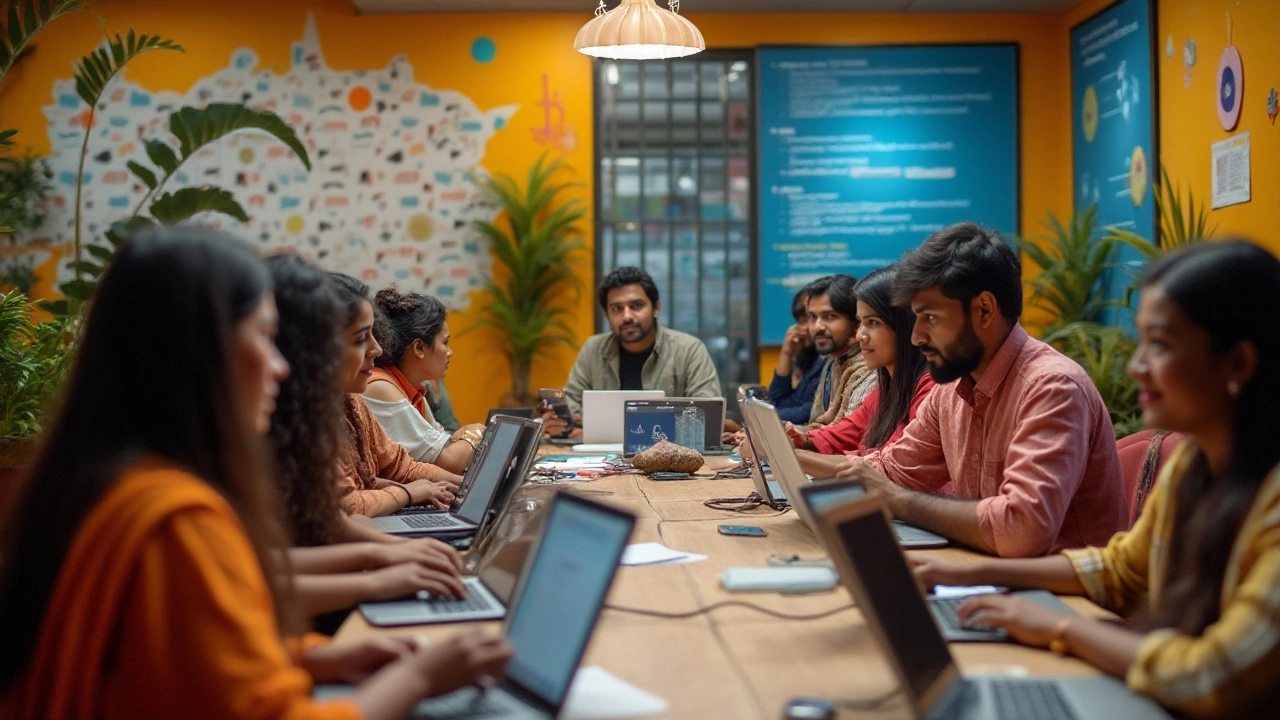Diving into the world of programming often starts with choosing the right language to learn. Python frequently comes up as a top choice, celebrated for its simplicity and readability. Whether you're stepping into coding for the first time or are a seasoned programmer eyeing another tool for your coding arsenal, learning Python could be your next important step.
But how long does it actually take to get a grasp of this language? The time it takes to learn Python is fluid, changing with one's learning environment, dedication, and prior experience with programming languages. For many, the journey begins with understanding the language's basic syntax, followed by the thrill of writing your first meaningful script. As your fingers dance across the keyboard, you'll find that Python can go from perplexing to intuitive with a bit of patience and practice.
What lies ahead is a pathway that guides you from basic understanding to proficiency. Along this path are tips, tricks, and valuable insights crucial for shaping your Python mastery. For those eager to embark on this educational escapade, Python's welcoming community and ever-growing resources are there to support and inspire.
- The Appeal of Python
- Estimating Time to Learn Python
- Python for Beginners
- Strategies for Effective Learning
- Beyond Basics: Advanced Python Concepts
The Appeal of Python
Python is often touted as a top language for both newcomers and experienced developers seeking a versatile tool in their programming arsenal. One of the major reasons for its popularity is its readability. Unlike languages that rely heavily on punctuation, Python syntax is designed to be clear and easy to follow. This feature alone makes it appealing to those new to coding, as it reduces the steep learning curve often associated with other programming languages.
In addition to readability, Python is known for its strong community support. With developers from all corners of the globe contributing to its development and improvement, newcomers are less likely to get stuck for long. This expansive support network is often highlighted in coding forums and online communities. The Python community is welcoming, which is crucial for anyone just stepping into the tech education ecosystem. John Zelle, a prominent figure in computer science education, once noted,
"Python is an excellent choice as a first programming language, not just because it is easy to learn, but because it encourages good habits, thanks to its readability and clean syntax."
The versatility of Python is another significant factor contributing to its widespread appeal. From web development to artificial intelligence, Python has proven its worth across various domains. Its simplicity doesn't undermine its power; rather, it enhances it by allowing developers to focus on solving complex problems without getting bogged down by intricate syntax details. This adaptability makes Python an attractive option for coding skills that stay relevant in a rapidly changing tech landscape.
Another aspect worth noting is Python's extensive library of modules and packages. These tools allow developers to extend the language's capabilities to suit specific needs, ranging from data visualization to machine learning. The ability to customize your toolset without reinventing the wheel is particularly enticing for those aiming to dive deep into heaving lifting tech applications like data analysis and machine learning. Python’s rich library ecosystem makes it invaluable for professionals aiming to upgrade their programming skills quickly and efficiently.
Moreover, Python is an open-source language, which means it's free to use and distribute. This attribute opens doors for many individuals around the world who might not have access to costly education systems. Thanks to being open-source, it boasts continuously evolving features, driven by a global network of contributors dedicated to enhancing its capabilities. This community-driven development ensures Python remains at the forefront of industry trends.
In educational settings, Python's appeal as a learning tool is significant. Many schools and universities have integrated Python into their curriculums as their language of choice for introductory programming classes. The simplicity of the language enables students to quickly understand fundamental programming concepts. As a result, students and educators alike appreciate its practicality and alignment with real-world applications. For these reasons and more, Python stands out as a preferred language, opening the door to opportunities in software development and various tech domains.
Estimating Time to Learn Python
Estimating how long it takes to learn Python is somewhat akin to asking how long a piece of string is. It hinges largely on one's prior experience with programming, the intensity of study, and the specific goals set by the learner. For absolute beginners, estimates range from a few weeks to a few months to cover the basics, given that you are dedicating a consistent amount of time daily. Those with prior coding experience, especially in languages like JavaScript or C++, might find themselves moving at an accelerated pace due to transferable skills gained from understanding coding logic and syntax structures.
The variety in time needed also extends to what you aim to achieve. Grasping the fundamentals such as understanding syntax, control flows, and functions might take around 6-8 weeks with regular practice. Becoming proficient enough to develop your own projects or contribute to an open-source initiative might extend this timeline to 6 months or longer. This timeframe allows for the reinforcement of learning through experience, troubleshooting errors, and the creation of more complex scripts that imitate real-world applications. Platforms like Codecademy or Coursera offer structured courses promising a full understanding within 3 to 6 months, which many find convenient and realistic. An interesting fact from a survey by Stack Overflow suggests that Python is one of the fastest-growing programming languages, which only heightens its appeal and suggests more dynamic support and resources becoming available.
Another aspect to consider is the method of learning. A self-paced online course could offer more flexibility but might take longer due to a lack of direct support. Alternatively, attending an immersive programming bootcamp might compress learning into a period as short as 12 weeks, thanks to the rigorous pace and hands-on projects integrated into the curriculum. Despite the challenging nature of such programs, many participants emerge with employable skills and a robust understanding of Python. According to a quote by renowned developer and educator, Guido van Rossum, "Computer programming is a craft and a trade. Like other crafts and trades, it takes time to learn and more time to master." Such a statement reminds us that while learning Python efficiently is important, the real measure of success is in application and continuous learning.
For those venturing into Python as their first foray into coding, a strong recommendation is to not only rely on formal courses but to also immerse oneself in the expansive Python community. Websites like GitHub are teeming with active projects that welcome new contributors. Engaging directly with these platforms can fast-track practical learning and connect you with other programmers who were once right where you stand. Continuous coding, engaging with community challenges, and staying updated with new Python libraries and updates like Pandas or TensorFlow will not only sharpen skills but also keep you abreast of industry changes.
Ultimately, the promise of Python lies in its versatility and the expansive support ecosystem backing it. However, the key takeaway is that learning is a deeply personal journey. For some, it may fit neatly within a few months of disciplined study, while for others, it might intertwine with years of experience that lead to mastery. Regardless of the timeline, Python remains a language that rewards curiosity and persistence, making the effort truly worthwhile.

Python for Beginners
Embarking on the journey to learn Python is akin to opening a gateway to endless possibilities in the realm of coding. For beginners, the initial steps often involve familiarizing themselves with Python’s versatile syntax, which is renowned for its clarity and simplicity. This makes Python an excellent entry point for those who have never written a line of code before. The phrase ‘hello world’ represents the traditional starting point where aspiring programmers can see their first tangible output on the screen, setting the stage for more complex problem-solving tasks.
Creating conditions where learning can thrive is essential, especially for first-timers. Engaging with Python through practical examples and interactive platforms like Codecademy or SoloLearn can be greatly beneficial. These platforms offer structured paths to follow which gradually increase in complexity, allowing learners to build foundational skills. Supplementing these with community-based forums like Stack Overflow or Reddit can provide additional support. Here, beginners can ask questions and gain insights from experienced developers who share tricks to navigate common pitfalls. A shared piece of wisdom often emphasized is to code consistently, even if for brief daily periods, to maintain the momentum of learning and internalize concepts effectively.
Aside from resources, it's equally important to understand the driving force behind why Python is so favored. According to the TIOBE index, Python has consistently ranked among the top programming languages, largely due to its application in data science, web development, and automation. Its dynamic nature allows developers to accomplish a lot with minimal code, providing both flexibility and efficiency. As one dives deeper into Python, learning through projects can be an enriching approach, allowing theory to meet practice and cementing one’s understanding through tangible results. "Python is the most powerful language you can still read," quips an influential figure in the tech community.
Paving the way to mastery requires building upon robust beginner knowledge. New learners should pursue understanding Python's core datatypes, such as strings, lists, and dictionaries. Mastering these basics sets up for more advanced topics down the line, like libraries and frameworks that make Python the backbone of countless modern technological applications. Nurturing a learning community and having a reliable mentor are also crucial in this development phase. Leveraging these resources can transform obstacles into opportunities to grow and learn more efficiently. By cultivating a learning environment that is supportive yet challenging, beginners can confidently evolve from understanding their first simple script to tackling more ambitious projects as they progress along their Python journey.
Strategies for Effective Learning
Embarking on the journey of learning Python can be thrilling, and embracing effective strategies will help you not only to tackle the challenges but also enhance your learning experience. The most effective learners immerse themselves deeply, setting clear goals and tracking their progress along the way. At the very start, determine why you want to learn Python. Are you aiming to boost your career in tech, automate repetitive tasks, or delve into fields like data science? Having a clear objective in mind will serve as a compass directing your learning trajectory. Setting smaller sub-goals, such as mastering particular coding skills or completing specific projects, can break up the overwhelming feeling of learning a new language.
A highly recommended approach is the "code daily" methodology. Consistent practice is key, and making it a daily habit will engrain the language more deeply into your mind. Spend at least an hour coding every day, and you'll likely notice significant improvements over weeks. To help with this, consider engaging in coding challenges, known for both their fun and educational value. Joining platforms like LeetCode or HackerRank can drive your progress by diving into diverse problem-solving scenarios.
Another effective angle is to join a community. The Python community is incredibly expansive and supportive. Whether through online forums, local meetups, or in chat groups, connecting with other learners and seasoned coders can provide you with invaluable insights and motivation. Community interaction not only helps you solve problems faster but exposes you to new ideas and techniques you may not have considered. This was echoed by renowned programmer Guido van Rossum, who once famously said,
"Code is read more often than it is written."These words highlight the importance of understanding and collaboration, often easier in a community setting.
Don't forget the importance of practical application. Theories can teach the concepts, but only practical application will turn them into skills. As you learn new concepts, try to implement them in real projects. Building personal projects based on your interests is a crucial way of consolidating learning and creates a portfolio showcasing your growing expertise. Perhaps it's time to automate a simple task or venture into web development. Personal projects also help to identify gaps in your understanding, turning them into areas for further exploration.
Staying informed about new trends and updates in Python is another important strategy. The language is constantly evolving with new libraries, frameworks, and tools. Regularly reading Python-related news and following knowledgeable contributors on social media can keep your skills fresh and innovative. For those who love numbers, consider this: Python has one of the largest repository ecosystems, with over 350,000 packages available to extend its capabilities.

Beyond Basics: Advanced Python Concepts
Once you've mastered the fundamentals of Python, a door to an expansive world of advanced concepts swings open. This journey can transform Python from a simple tool in your programming toolkit to a powerful ally capable of tackling complex tasks. Advanced Python concepts go beyond syntax familiarity and dive into more sophisticated territories that challenge your problem-solving skills and elevate your programming artistry. The leap from beginner to advanced user involves embracing object-oriented programming, understanding decorators, and integrating generators into your workflow. With these tools, you can enhance efficiency and write cleaner, more maintainable code.
Object-oriented programming (OOP) in Python allows you to create classes and objects, bringing structure to your code. It empowers developers to encapsulate data and functions in neat bundles, fostering reusability and scalability of code. Understanding the OOP paradigm involves grasping concepts like inheritance, polymorphism, and encapsulation. These principles are like building blocks, creating a sturdy framework that supports complex applications. Without these foundations, the edifice of application code would crumble under its own complexity. To illustrate, inheritance allows you to build new classes on the foundation of existing ones, promoting code reusability and reducing redundancy.
Decorators in Python add a layer of functionality to existing code without modifying its structure. They are like outfits for functions, allowing you to dress them up with additional behaviors. This versatile concept is crucial when you want to enforce rules, manipulate output, or log function calls. The ability to extend functionality in such a seamless manner is what makes decorators a favorite among experienced Python programmers. As a pro tip, practice applying decorators to simple functions and gradually increase the complexity. This hands-on approach cements the concept and inspires creative applications that solve real-world problems.
Generators are yet another powerful feature provided by Python, enabling developers to handle large data sets efficiently. Unlike regular functions that return a single result, generators yield their results one at a time, flowing like a river of data. This lazy evaluation approach conserves memory, making Python ideal for data-heavy tasks such as logging or data analysis. A famous quote in the programming community that captures the essence of Python reads: "Beautiful is better than ugly," attributed to Tim Peters in 'The Zen of Python'. Generators align with this philosophy by encouraging streamlined and elegant coding patterns.
To grasp these advanced Python concepts, it's crucial to explore hands-on projects where you can apply them practically. Whether it's a small personal undertaking or contributions to open-source projects, applying these concepts in real scenarios deepens understanding. As the Python community is vast and incredibly supportive, numerous resources such as tutorials, code challenges, and discussion forums are there to guide you in your advanced learning journey. Delving into these topics may seem daunting initially, but with persistence and passion, you'll soon find yourself creating sophisticated Python applications with ease.

Write a comment